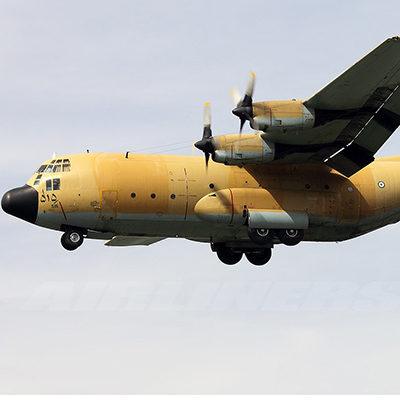Sites
C-130
Mohsen Shir-Muhammad
122 Views
The C-130 transport aircraft played an important role in supporting and airlifting Iranian military forces during the Iran–Iraq War.
Designed and built by the U.S. Lockheed Corporation, the C-130 made its first successful test flight in 1954. Measuring 29.79 meters in length, 40.41 meters in wingspan, and 11.66 meters in height, it has a top speed of about 600 km/h, a service ceiling of 33000 feet, and a range of 7800 kilometers.[1] It is also capable of taking off and landing on short and unpaved runways. When operating at full load and on a short runway, the C-130 can use eight JATO rockets to facilitate takeoff.[2]
This aircraft has been produced in multiple models and is capable of carrying out a wide range of missions, including troop transport, medical evacuation, and search-and-rescue operations. Some variants are also used as airborne command posts and aerial refueling tankers.[3] The AC model is armed with multiple weapons, including a 105 mm howitzer, 40 mm and 20 mm cannons, and a 7.62 mm machine gun.[4] The C-130 carries a crew of four and can transport either 92 fully equipped troops, 64 paratroopers, or 73 stretcher patients accompanied by 2 medical attendants.[5]
The first C-130s entered service with the Imperial Iranian Air Force in 1963 and were stationed at Mehrabad Air Base.[6] Later that same year, more C-130s were deployed to Shiraz Air Base.[7] Gradually, by 1978, Iran had purchased 50 C-130s in both E and H models.[8]
Following the Islamic Revolution in February 1979 and the outbreak of unrest in Kurdistan, C-130s were used to transport personnel, cargo, and ammunition in support of military forces.[9]
On September 22, 1980, Mehrabad Air Base was among the first airfields targeted in Iraqi air strikes, and one C-130 was destroyed.[10] With the start of the enemy’s ground invasion, C-130s began transporting military personnel to the frontlines.[11]
The 1st Transport Squadron at Mehrabad and the 7th Transport Squadron at Shiraz carried out many transport missions—moving troops, cargo, ammunition, and the injured—throughout the Iran–Iraq War.[12] For example, Shiraz-based C-130s transported 1500 Iranian troops from Mashhad to Khuzestan for Operation Beit al-Muqaddas.[13] During this period, intelligence and reconnaissance missions were also conducted using special EC-130 aircraft known as “Khufash” (Bat) from the 1st Transport Squadron at Mehrabad.[14] These tactical transport missions involved a C-130 equipped with highly sensitive electronic surveillance systems, which, in times of crisis, would fly continuous patrols along Iran’s western and southwestern borders to monitor Iraqi Air Force movements. One of Khufash’s key tasks was to alert Iranian radar sites and command centers whenever enemy aircraft were headed towards Iran or the war zones. Upon receiving such alerts, interceptor aircraft were scrambled to either destroy the intruders or force them to abort their mission and retreat.[15]
The enemy made multiple unsuccessful attempts to shoot down the Khufash aircraft. For instance, on November 30, 1981, five Iraqi aircraft attacked the Khufash during Operation Tariq al-Quds. One of them, flying with its radar switched off, closed to within 25 miles of the C-130, but the aircraft successfully evaded and escaped the area.[16]
Following the grounding of P-3F maritime patrol aircraft in mid-1985, C-130s were deployed and carried out aerial maritime patrol missions until October 1986.[17] In these patrol missions, crews from the tactical transport squadron would be deployed to Bandar Abbas for one-week assignments. Each day, they would take off in the morning from the northern mouth of the Persian Gulf, fly their patrol route, and by sunset cover the area all the way to Gavater (the border with Pakistan in the Gulf of Oman).
Using both visual and radar reconnaissance, they would report detailed statistics on all ships entering and leaving the Persian Gulf. These flights typically lasted around eight hours and involved precise identification of vessels carrying weapons to Iraq, enabling Iranian fighter aircraft to target them effectively.[18]
During the Iran–Iraq War, several accidents involving C-130s occurred. One of them took place in the fall of 1981. On September 29, 1981, following the successful conclusion of Operation Thamen al-Aemmah (as), senior Army and Islamic Revolutionary Guard Corps (IRGC) commanders decided to travel to Tehran to brief Imam Khomeini (ra) on the breaking of the Abadan siege. Near Kahrizak, all four engines of their aircraft failed after an explosion in the cabin.[19] The pilot managed to land the powerless aircraft, but due to the failure of the left-side landing gear to lock, the wing struck an irrigation mound when landing and the aircraft caught fire. The pilots, crew, and some passengers survived, but several high-ranking military commanders were martyred, including Brigadier General Valiollah Fallahi, Deputy Chief of Staff of the Army; Colonel Javad Fakouri, Commander of the Iranian Air Force; Colonel Mousa Namjoo, Minister of Defense; Yusef Kolahdouz, Deputy Commander of the IRGC; and Muhammad Jahanara, Commander of Khorramshahr IRGC. Investigations done by experts from both the Iranian and Pakistani Air Forces showed that the explosion had been caused by a high-voltage electrical fault aboard the aircraft.[20]
Another incident took place on November 2, 1986, when a C-130 transport plane flying from Kermanshah to Zahedan crashed into a mountain near Zahedan Airport due to a technical failure. As a result, all aboard, including 91 members of the 88th Armored Division, were martyred.[21]
After the war, the C-130 underwent a series of upgrades by Iran Aircraft Industries, including enhancements to its avionics, structural components, wings, fuselage, and engines. The upgraded aircraft completed its first successful flight on September 26, 2010.[22]
Today, Mehrabad Air Base continues to support other air bases across the country, and overhauls of various Air Force fighters and transport planes — including the C-130 — are carried out at the base.[23] Major maintenance for this type of aircraft is typically carried out at Shiraz Base.[24]
[1] Namazi, Mahmoud va Digaran, Havapeyma-shenasi (Studying the Aircraft), Tehran, Chapkhane-ye Niroo-ye Havaei Artesh, 1371, p. 78.
[2] Ibid., p. 76.
[3] Ibid., p. 77.
[4] Ibid., p. 79.
[5] Babaei, Muhammad-Reza, Parandeh-haye Poladin-e Iran, Vol. 2: Havapeyma-haye Shekari va Tarabari (Iran’s Steel Birds, Vol. 2: Fighter and Transport Aircraft), Tehran, Entesharat-e Sabz Rayan Gostar, 1394, p. 251.
[6] Tahvil-e Havapeyma-haye C-130 be Niroo-ye Havaei-ye Shahanshahi (Delivery of C-130 Aircraft to the Imperial Air Force), Majale-ye Niroo-ye Havaei, No. 213, Tir 1342, p. 3.
[7] Tarikh-e Nabardhaye Havaei Defa Muqaddas, Vol. 3: Amaliat-e Kaman 99 Mosoom be 140 Farvandi va Kasb-e Bartari-ye Havaei bar Doshman (History of Air Battles in Sacred Defense, Vol. 3: Operation Kaman 99 Known as Operation 140-Aircraft and Gaining Air Superiority over the Enemy), Tehran, Markaz-e Entesharat-e Rahbordi-ye NAHAJA, 1396, p. 58.
[8] Tarikh-e Nabardhaye Havaei, Vol. 1: Ta Aghaz-e Tahajom-e Sarasari (History of Air Battles, Vol. 1: Until the Start of the General Invasion), Tehran, Markaz-e Entesharat-e Rahbordi-ye NAHAJA, 2nd ed., 1395, p. 72.
[9] Ibid., p. 174.
[10] Heyat-e Tadvin-e Tarikh-e Defa Muqaddas, Taqvim-e Mostanad-e Amalkard-e Niroo-ye Elahi-ye Havaei Artesh Jomhuri-ye Eslami-ye Iran, Vol. 3 (Documented Calendar of the Holy Air Force’s Performance, Vol. 3), Mehr 1359, Tehran, Markaz-e Entesharat-e Rahbordi-ye NAHAJA, 1397, Pp. 10, 12, 110.
[11] Tarikh-e Nabardhaye Havai Defa Muqaddas, Vol. 3: Amaliat-e Kaman 99 Mosoom be 140 Farvandi va Kasb-e Bartari-ye Havaei bar Doshman (History of Air Battles in Sacred Defense, Vol. 3: Operation Kaman 99 Known as Operation 140-Aircraft and Gaining Air Superiority over the Enemy), p. 201.
[12] Tarikh-e Nabardhaye Havaei Defa Muqaddas, Vol. 2: Amaliat-e Havaei Avalin Pasokh (History of Air Battles in Sacred Defense, Vol. 2: First Response: Air Operation), Tehran, Markaz-e Entesharat-e Rahbordi-ye NAHAJA, 1395, p. 16.
[13] Aryani, Hamed, Parvaz az Fars ta Aseman-e Khalij-e Fars (Flying from Fars to the Persian Gulf), Mahname-ye Saf, No. 417, Bahman 1394, p. 20.
[14] Tarikh-e Nabardhaye Havaei Defa Muqaddas, Vol. 2: Amaliat-e Havaei Avalin Pasokh (First Response: Air Operation), p. 16.
[15] Khalili, Hussain, Nabardhaye Havaei-ye Iran (Iranian Air Battles), Entesharat-e Iran Sabz, Tehran, 1398, p. 339.
[16] Habibi, Nikbakhsh va Ali Gholami, Defa Muqaddas va Qodrat-e Havaei (Sacred Defense and Air Power), Tehran, Markaz-e Entesharat-e Rahbordi-ye NAHAJA, 1397, p. 331.
[17] Gholamnezhad, Jafar, Niroohaye Arteshiyan-e Fars dar Defa Muqaddas (Fars Military Forces in Sacred Defense), Shiraz, Farhangestan-e Adab, 1400, p. 70.
[18] Mama, Muhammad, Tarabari-ye Havaei-ye Taktiki Gereh-goshaye Jebheha (Tactical Air Transport, the Key to Fronts), Mahname-ye Saf, No. 359, Mehr 1389, p. 98.
[19] Ghazi-mir-saeid, Hekmat, Cheshmi dar Aseman: Yadman-e Amir Sartip-e Khalaban-e Shahid Javad Fakouri (Eye in the Sky: Memorial of Brigadier General Pilot Martyr Javad Fakouri), Entesharat-e Aqidati Siyasi Artesh, Tehran, 1383, Pp. 165, 167.
[20] Ibid., Pp. 179, 183.
[21] Moasesse-ye Farandish, Ruydad-haye Sal 1365 (Events of the Year 1986), Tehran, Entesharat-e Farandish, 1366, p. 164.
[22] Jelveh-haye Eqtedar (Manifestations of Power), Mahname-ye Saf, No. 360, Aban 1389, p. 13.
[23] Bar Faraz-e Eqtedar: Goft-o-go ba Sartip-e Dovvom Muhammad Tasvieh-chi Farmande-ye Paygah-e Havaei-ye Shahid Lashkari (Above Power: Interview with Brigadier General Muhammad Tasvieh-chi, Commander of Shahid Lashkari Airbase), Mahname-ye Saf, No. 384, Bahman 1391, p. 27.
[24] Aryani, Hamed, Ibid., p. 21.





